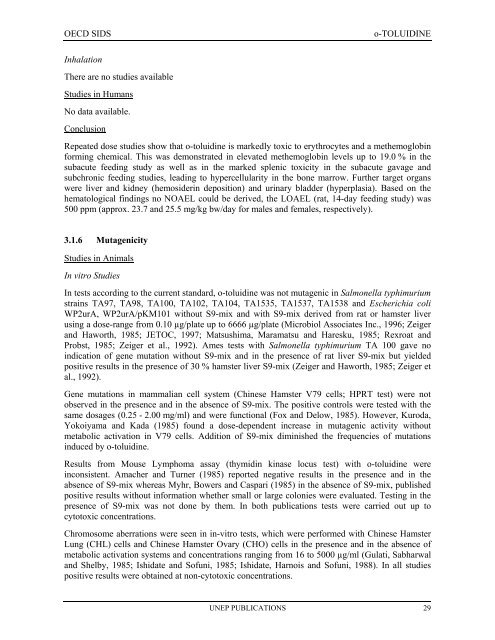o-TOLUIDINE CAS N°: 95-53-4 - UNEP Chemicals
o-TOLUIDINE CAS N°: 95-53-4 - UNEP Chemicals
o-TOLUIDINE CAS N°: 95-53-4 - UNEP Chemicals
Create successful ePaper yourself
Turn your PDF publications into a flip-book with our unique Google optimized e-Paper software.
OECD SIDS o-<strong>TOLUIDINE</strong><br />
Inhalation<br />
There are no studies available<br />
Studies in Humans<br />
No data available.<br />
Conclusion<br />
Repeated dose studies show that o-toluidine is markedly toxic to erythrocytes and a methemoglobin<br />
forming chemical. This was demonstrated in elevated methemoglobin levels up to 19.0 % in the<br />
subacute feeding study as well as in the marked splenic toxicity in the subacute gavage and<br />
subchronic feeding studies, leading to hypercellularity in the bone marrow. Further target organs<br />
were liver and kidney (hemosiderin deposition) and urinary bladder (hyperplasia). Based on the<br />
hematological findings no NOAEL could be derived, the LOAEL (rat, 14-day feeding study) was<br />
500 ppm (approx. 23.7 and 25.5 mg/kg bw/day for males and females, respectively).<br />
3.1.6 Mutagenicity<br />
Studies in Animals<br />
In vitro Studies<br />
In tests according to the current standard, o-toluidine was not mutagenic in Salmonella typhimurium<br />
strains TA97, TA98, TA100, TA102, TA104, TA1<strong>53</strong>5, TA1<strong>53</strong>7, TA1<strong>53</strong>8 and Escherichia coli<br />
WP2urA, WP2urA/pKM101 without S9-mix and with S9-mix derived from rat or hamster liver<br />
using a dose-range from 0.10 µg/plate up to 6666 µg/plate (Microbiol Associates Inc., 1996; Zeiger<br />
and Haworth, 1985; JETOC, 1997; Matsushima, Maramatsu and Haresku, 1985; Rexroat and<br />
Probst, 1985; Zeiger et al., 1992). Ames tests with Salmonella typhimurium TA 100 gave no<br />
indication of gene mutation without S9-mix and in the presence of rat liver S9-mix but yielded<br />
positive results in the presence of 30 % hamster liver S9-mix (Zeiger and Haworth, 1985; Zeiger et<br />
al., 1992).<br />
Gene mutations in mammalian cell system (Chinese Hamster V79 cells; HPRT test) were not<br />
observed in the presence and in the absence of S9-mix. The positive controls were tested with the<br />
same dosages (0.25 - 2.00 mg/ml) and were functional (Fox and Delow, 1985). However, Kuroda,<br />
Yokoiyama and Kada (1985) found a dose-dependent increase in mutagenic activity without<br />
metabolic activation in V79 cells. Addition of S9-mix diminished the frequencies of mutations<br />
induced by o-toluidine.<br />
Results from Mouse Lymphoma assay (thymidin kinase locus test) with o-toluidine were<br />
inconsistent. Amacher and Turner (1985) reported negative results in the presence and in the<br />
absence of S9-mix whereas Myhr, Bowers and Caspari (1985) in the absence of S9-mix, published<br />
positive results without information whether small or large colonies were evaluated. Testing in the<br />
presence of S9-mix was not done by them. In both publications tests were carried out up to<br />
cytotoxic concentrations.<br />
Chromosome aberrations were seen in in-vitro tests, which were performed with Chinese Hamster<br />
Lung (CHL) cells and Chinese Hamster Ovary (CHO) cells in the presence and in the absence of<br />
metabolic activation systems and concentrations ranging from 16 to 5000 µg/ml (Gulati, Sabharwal<br />
and Shelby, 1985; Ishidate and Sofuni, 1985; Ishidate, Harnois and Sofuni, 1988). In all studies<br />
positive results were obtained at non-cytotoxic concentrations.<br />
<strong>UNEP</strong> PUBLICATIONS 29
















